| Report Type | Full |
| Peak(s) |
Mt. Yale - 14,200 feet |
| Date Posted | 04/03/2015 |
| Date Climbed | 03/21/2015 |
| Author | Tim A |
| Almost-Sunrise Summit in Almost-Winter |
|---|
|
This is a "real" report with words and stuff, but my skills at showing my time in the mountains as I experience them is better expressed in the above video than the below report, so feel free to skip the book report and "cheat" by watching the movie instead. After resting up for three full days in San Isabel National Forest following my ascent of Atlantic Peak, I was looking at options for my last real day of spring break vacation before heading back to Texas. I had considered the East Ridges of Humboldt or Elbert, but following the dumping of snow on 3/19, I figured all trenches would be gone and so I needed a shorter day. Yale from Denny Creek seemed like the right choice. Yale eluded me last summer in early August, when I picked it as my final hike to cap off nearly two full months of camping/hiking in CO during my summer break. I had rigged camp high on Cottonwood Pass, around 11,000ft, and despite having slept above 9K nearly all summer, that night was miserable, and I elected to call it off as I woke with a blistering headache. A few months later, in late September, I was back for a three-day weekend to see the Aspens changing, and had planned again on doing Yale, but the week before the trip I came down with bronchitis, and so ended up just milling around the summit of Cottonwood Pass instead of attempting the route. It was with this history in mind that I set up my tent in the snow on the side of the road about a half mile above the Denny Creek TH. Just a few hundred feet past this point, the ice and snow on the road became more substantial and I didn't want to risk trying to get my car higher for a look at better camping spots. My plan was for a 3am start, for a few reasons. I love early starts, even in winter when there isn't really a thunderstorm risk. There is something to the feeling you get being alone and "first" on a trail or summit on any given day. I can remember several instances where I was at the base of a route or couloir at dawn, well ahead of the crowd, yet was still disappointed to look up and see a headlamp already at the top of the chute or bobbing along the ridgeline. I wanted to be that headlamp this time. The other primary reason was to avoid my least favorite activity in the mountains. The one that, while I'm engaging in it, fills my head with all the voices of my friends and family who constantly ask "why would you want to go and suffer on a mountain instead of getting margaritas on the beach?" During even short stretches of postholing, I sink into a nervous state of anxiety and fear, borne out of a traumatizing experience in the willows of Scott Gomer Creek back in March of 2013. I bonked during my descent off Bierstadt's west slopes, and bonked around the same time the snow lost all its stability to hold up due to afternoon heating AND at the moment my partner and I got cliffed out and realized we had lost the route. While I made it safely off the mountain that day, the fear of ever encountering that state of sheer exhaustion coupled with running out of water and trail to follow and sinking up to the hips with every step into the snow never really leaves you. Earlier in the week, during the descent off Atlantic's West Ridge back into the Mayflower basin, I had revisited postholing on a much smaller level, and while I made it through that just fine, it's simply not pleasant. I think postholing is like getting a hangover: everybody despises it, it's totally preventable, yet most of us, even after "learning our lesson," still manage to suffer it on a regular basis. Not me. Not this time. My tent set-up promised a very short break of camp at 2am the next morning as well as decent views of Yale. 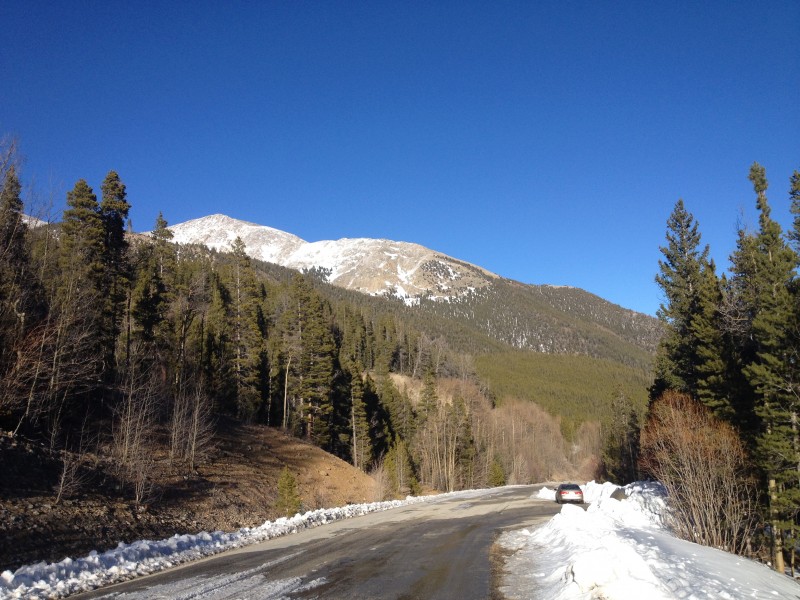 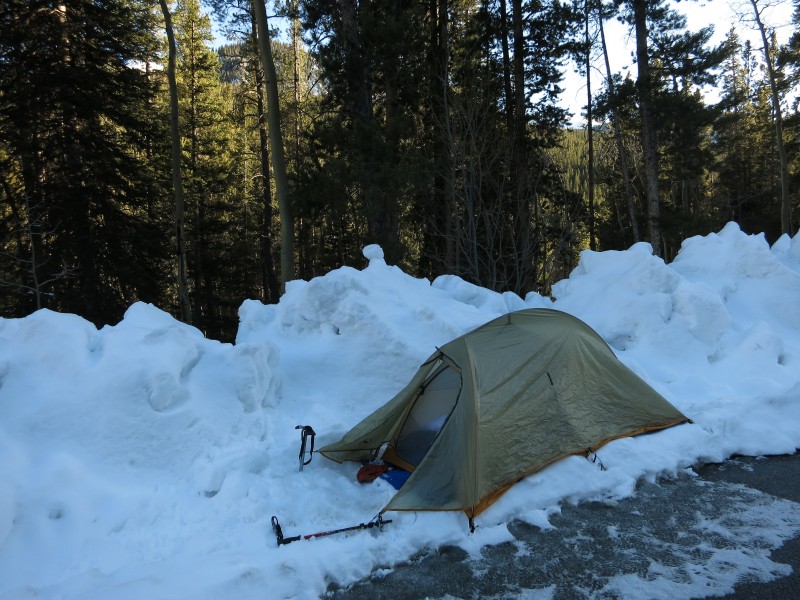 I crawled into my bag at 7pm, knowing full well it would take me some time to fall asleep. I didn't realize it would be the start of my poorest night ever in the mountains. From 5pm, when I pulled off to the road and began setting up, until nearly 8pm, only a single car had driven that far up the road to see how far they could get. I could hear them coming about a minute before they actually drove past because of the quiet of my location as well as the amplifying effects the mountainous walls have on both sides of the road. They drove past, slowing down to check out my odd set up, before continuing up the last few hundred feet I had already investigated and finding it impassable. At which point, they would turn around and head back down. I figured, "one car in three hours during the afternoon, this should be a quiet night." But the citizens of Buena Vista, or the out of towners they were sheltering, had other plans this evening. Right on schedule, I began getting drowsy about ninety minutes after zipping into the tent, and so I stashed my kindle into my sleeping bag to keep it from freezing and laid back to pass out. It was around 845ish. I hear, down the road a ways, the faintest sound of a car revving its engines up to climb up the gradient of the pass. The sound continues getting louder and louder, and I make out that it's a diesel engine, likely powering some other Texan's F350 and giving him the confidence to try bludgeoning his way through the snowed-in pass higher up. He eventually roars past me, and a few moments later, I hear his engine suddenly drop in volume, followed by a few short growls and snorts before revving up again and heading back my direction. He roars past again going back down. What little bit of quiet and restfulness I'd let my body sink into for the past two hours was completely ruptured, and worse, it was now too cold for me to have my hands outside my bag without gloves on, and with gloves, I can't turn pages on my kindle. Score one for paper books. With no other choice, I lay there and tried drifting off again. From around 8-1am, I counted seven additional vehicles (or the same one d-bag) try their luck at driving up past my setup and getting higher onto the pass. Each vehicle ultimately made two passes, as there was no way through higher up, and there were no other pull-outs past my spot. Around 11pm, I finally starting getting winks and nods of sleep between the passing banshees, but when the last car of the night drove past me at 1:12am, I decided to cut my losses and break camp to start the hike. I was on maybe two hours of sleep, but surprisingly enough, didn't have a headache nor feel groggy. The adrenaline kicked in and kept me afloat for the next ten hours. That, and the curiosity about what the hell so many people were trying to do driving up Cottonwood pass that late at night when the signage clearly indicates all along the road that they won't make it. I quickly broke camp, headed down to the TH, and cooked breakfast on top of my car, whispering "sorry" quietly to myself as my headlights grazed past two tents set up at the TH. I didn't want to wake anybody else up at that ungodly hour. I was ready to go at around 230am, but elected to hang out in the parking lot another half hour reading my kindle, as I didn't want to be on the ridgeline before dawn when I would need to see what I was scrambling over. At 3, I hit the trail, and made pretty quick progress thanks to a great trench which survived the recent storm. 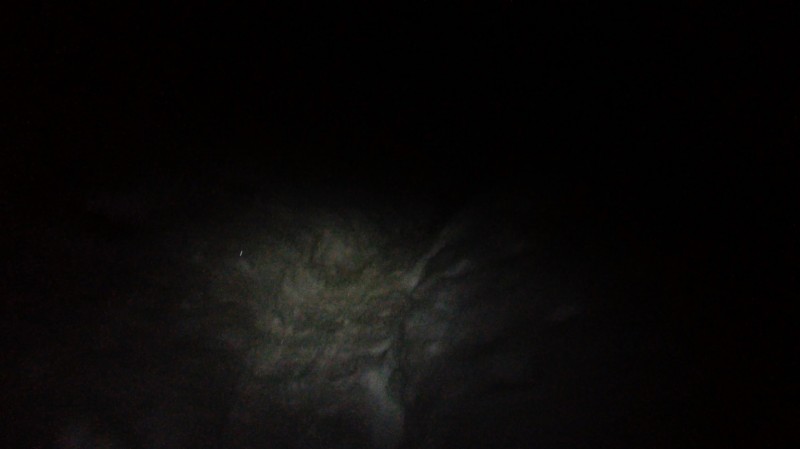 The snowshoes were stashed to my pack for the trip down should they be necessary. Everyone who's hiked pre-dawn through the forest solo knows the primal sense of anxiety one encounters during those miles. The added element of winter with the snow all around further compounds this. I would stop occasionally just to listen for other things crunching through the night, but there was nothing, not even the usual wind rustling the tops of the trees. The ring of the ears which accompanies every silent moment of life was my only feedback. I pictured a mountain lion stalking me alongside the trail, but simply prayed it wasn't wounded or hungry enough to try new cuisine today. I clicked my poles together every few paces, reminding the creatures of the night that I was not a four-legged beast of burden crunching through the snow. At about 5am, I hit a meadow around 11,300' where the trench braided in three different directions. I consulted my GPS, but during the entire morning so far, I had been slightly off of the path marked on the GPS and so it wasn't a huge help given my current distance from the marked trail on the map. With no moon, it was pitch black save for the few feet of illumination my headlamp cast, and so I couldn't scan ahead to see about ruling out any of the braids. I picked the route most traveled. A quarter mile later, the trench turned into a series of traumatic looking postholes that ran straight into a bunch of willows. Memories of Scott Gomer jolted into my head, and I back-tracked to the meadow and tried the next braid. This one wasn't a trench at all, but a series of slashes and cuts through the snow indicating old ski lines. I followed them about half a mile before they disappeared into a clump of fir trees. Crap. I walked the half mile back to the meadow and checked the GPS again. I'd now been at this juncture for close to forty minutes and was getting frustrated. The third braid of trail I noticed earlier was even more faint and ultimately disappeared just a few dozen feet past the juncture into fresh powder, so I turned back and returned to the intersection. I contemplated waiting for dawn to bring some needed light which might help get me my bearings, but sunrise, as my GPS gently reminded me, was still almost an hour and a half away. The sky hadn't even taken that dark tinge of blue yet, but continued its black stare back down at me. I snacked, drank some water, and decided to follow the postholing mess I had first pursued, figuring it was some party who had gotten off route on descent and hence that it must eventually run back into the primary trench somewhere higher up. I picked through the postholing nightmare of willows for about 3/4 of a mile before coming to the base of a ridiculously sketchy slope that angled steeply up. The track didn't switchback up, but went straight for it, with deep gouges in the snow every few feet. At the base of this slope, with trees clustered tightly around it, was an inflated inner-tube, which lent to my theory that some person coming down hopped in their tube to come down this slope. Going up looked very unpleasant, but I wasn't about to turn around again, and fortunately, I was now heading back in the direction of the notated trail on my GPS, which I had veered from considerably by taking this route. While I couldn't see the top of this slope, I figured the trail was surely at the top of it. I stowed my poles and took out the axe, as a fall on this slope with the frozen snow would end with a long ride crashing into a tree. The next twenty minutes were the hardest of the day, as I climbed what was probably a 30-35o slope in deep powder. I stayed directly on top of the earlier postholes and probed around quite a bit before committing. The trees were so thick that the unconsolidated powder didn't pose much of an avalanche hazard, but I was more concerned with falling into a tree-well after having watched a horrifying youtube video of such a debacle a few weeks prior to the trip. I eventually topped out on the slope and found trench again, which was divine. Eager to make up my lost time, I made quick work through it, coming up to treeline just a few minutes later. Here, another avalanche consideration popped up. The trench went seemingly straight up a slope I sincerely wanted to avoid, and having researched the route, I remembered reading that one wants to veer left quite a bit before gaining the upper shoulder. The darkness compounded my anxieties and clouded everything. I could make out a faint luminescence from the snow-capped peaks all around me, but there was still no real light from any source other than my headlamp, and so I couldn't judge how high the slope I was looking at was, nor how steep. I probed around a bit with my axe and found a few inches of melt crust on top of bottomless powder, similar to my earlier trek on Atlantic, so that sketched me out a bit, but the trench was so well constructed and stable that I just committed to staying in it and moving quickly. On my descent, this slope would turn out to be much mellower than my night-inspired impressions had led me to believe. Now out in the open, I relaxed a bit and followed the trench up the shoulder where the snow thinned considerably around some large boulders. I went past these about a quarter mile to find a really steep snow face with bulletproof snow and steps cut into it. This definitely wasn't on the route: I knew I was looking for switchbacks, but it headed the right direction, and it was solid, so I ditched my snowshoes near the boulders and my trekking poles right at the base of the slope. Make a note of this for later... Having carried my crampons all day on Atlantic without ever using them, I hadn't brought them to Yale, but was wearing microspikes which I put on at the car. This made gripping the steps a little more challenging, but all in all, this was the funnest part of the day. I hadn't come to the west slopes of Yale expecting a genuine snow climbing experience, but this 250ft slope of 33 degrees did a nice job of delivering. Once again, on the descent with sunlight, I would see how obvious the real trail was and how closely I had missed it by. In this particular instance, I was glad to have missed it. Now on the upper slopes of Yale, there was a faint glow to the southeast, and I could finally make out the unmistakable bump that is Yale's summit. The surrounding peaks began to reveal themselves in the clarity of the morning, and as I continued working higher onto the slope, I would make frequent stops to just turn and stare. 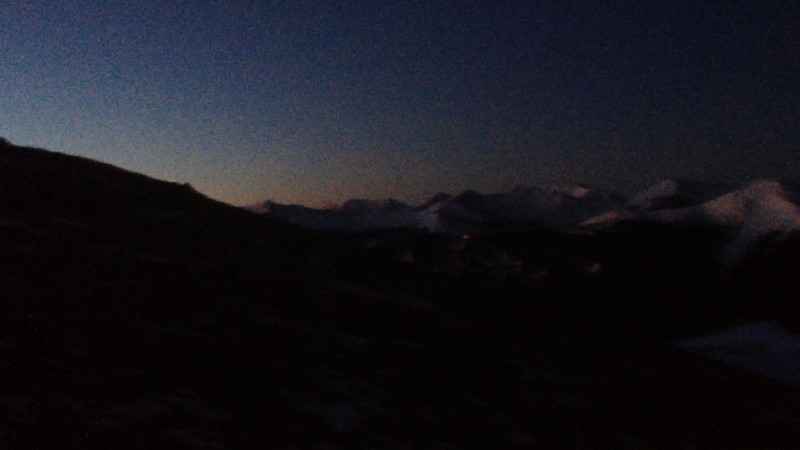 Various shades of morning color on central Sawatch.  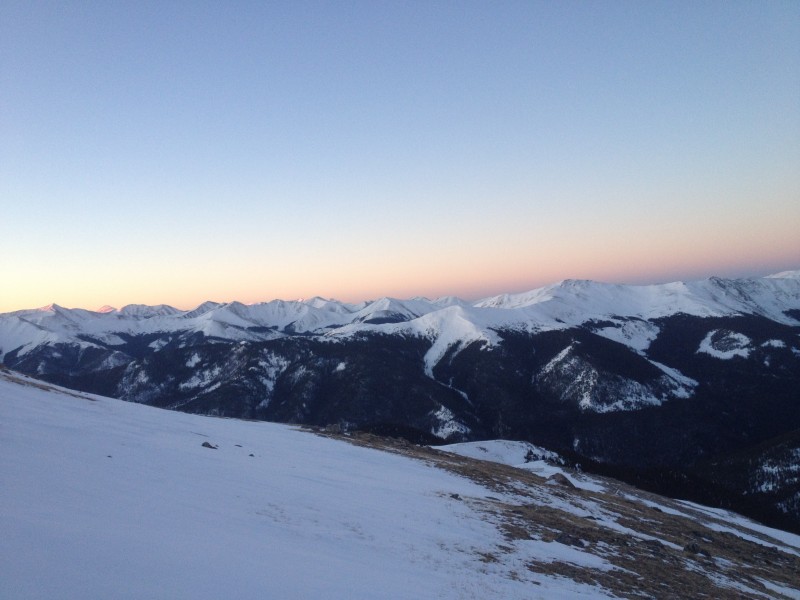 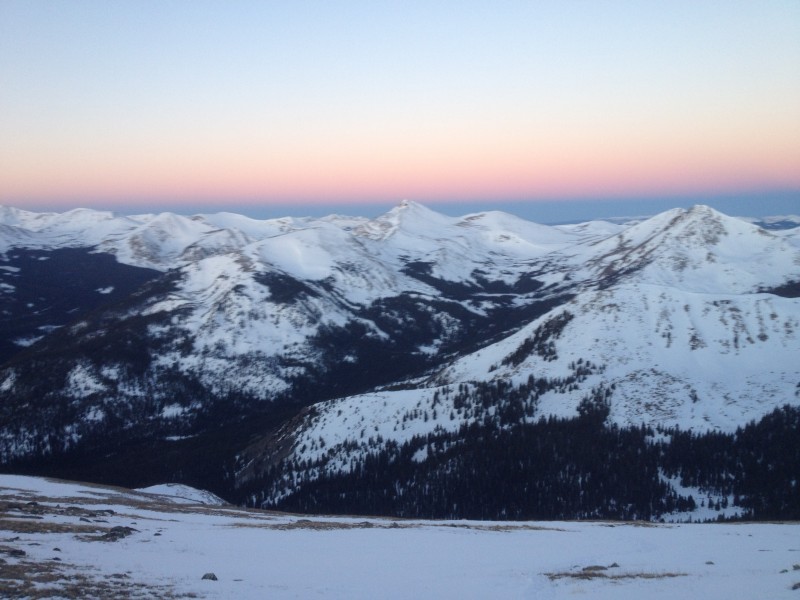 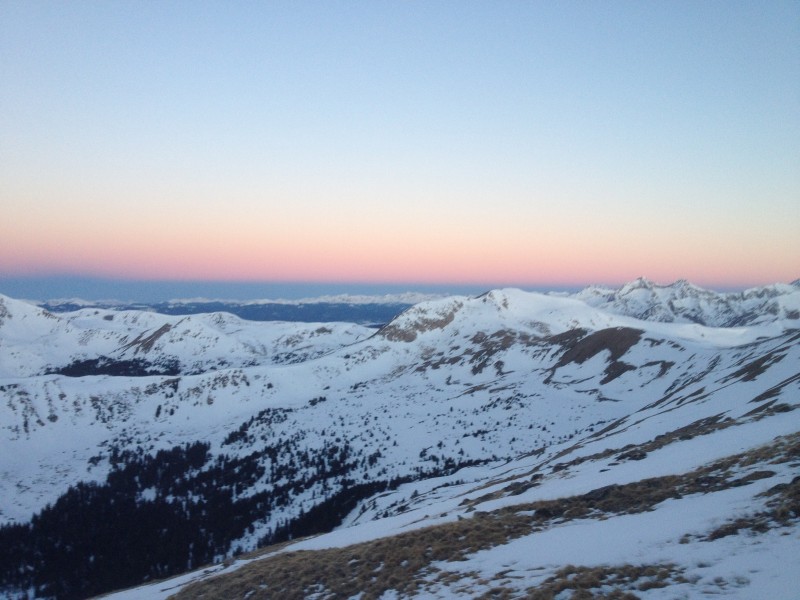 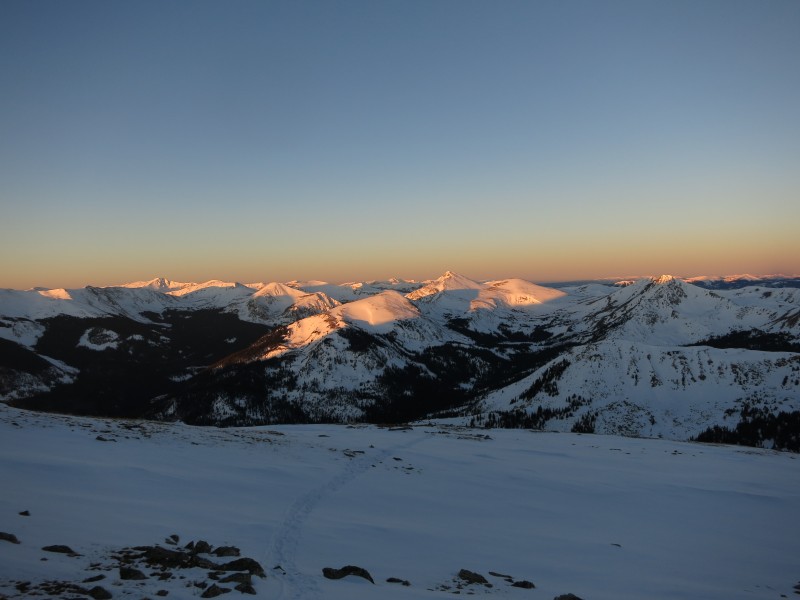 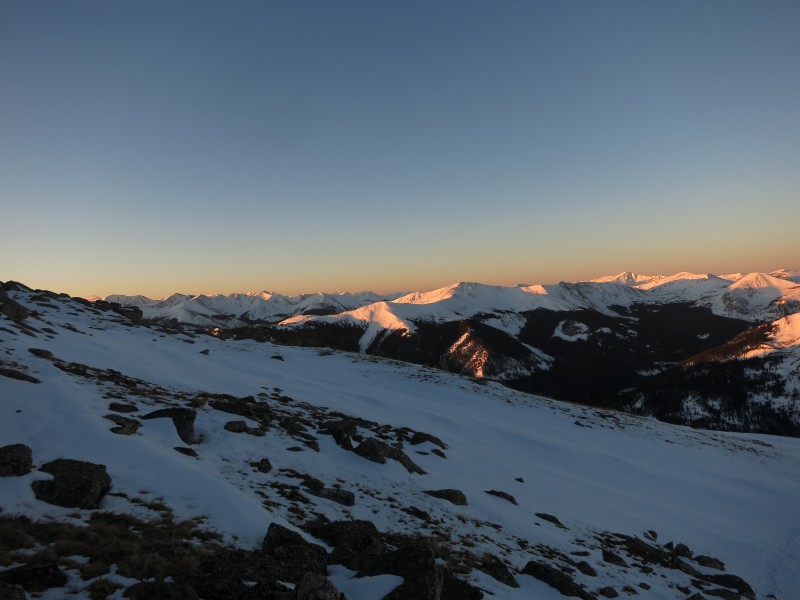  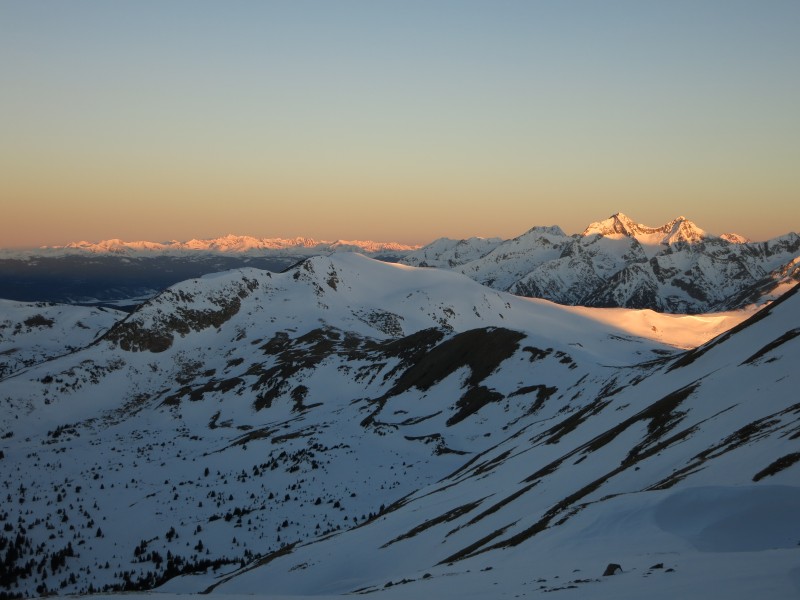 The final walk up moderate snow to reach the summit. The slope was crossed by numerous glissade trails, all on bulletproof snow. I picked one and headed up.  While I had wanted to be on the summit ridge in time for sunrise, I was only about 45 minutes behind that schedule (minutes that obviously could have been saved had I committed to the braided trail the first time). After reaching the ridge, my tired body was feeling both the lack of sleep and the elevation. The summit didn't appear to be far off. 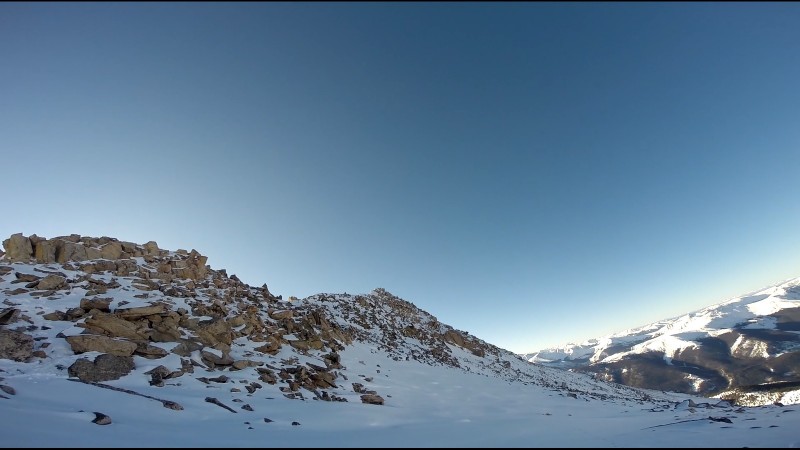 The final traverse across the ridgeline took me an additional 45 minutes. While there was a clear trail to follow, the new powder that had fallen recently didn't have so much as a single centimeter of melt crust covering it, so it was very tedious negotiating my way through it, with each step sinking at least to my ankles and oftentimes my knees. I sincerely enjoyed the ridgeline though, I'm quickly finding that ridge-scrambles, especially in winter, are my favorite routes on the high peaks of CO. I tried to stay as high and direct on the ridge as possible due to the obviously unstable snow blanketing the east face, and the blocky and cliffy aspects off to the west. This provided me with a few small number of class 3 moves which spiced up the route considerably. 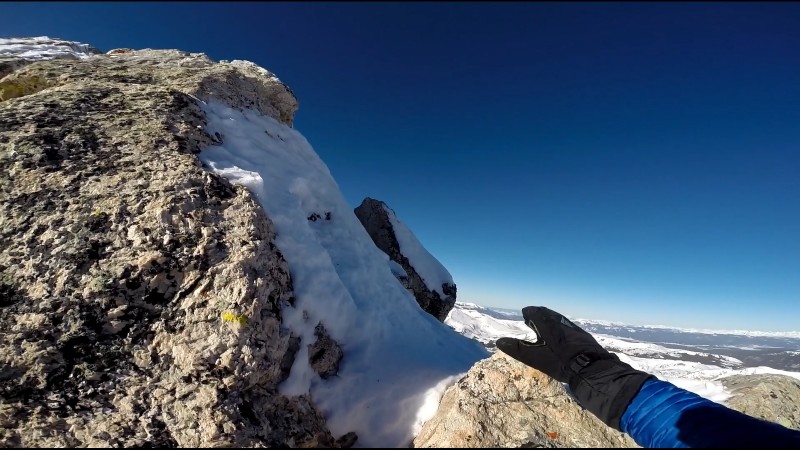 Before long, came around a cairn and saw the summit about a half mile off. That's always a glorious moment when you realize you will for sure make the summit on a given day.  Then, you get there, and it's not the summit. It's another jug away, or at least it appears to be. That's always a disorienting moment, to go from pure confidence to sudden trepidation. At last I came to the last leg, or what appeared to be anyway. 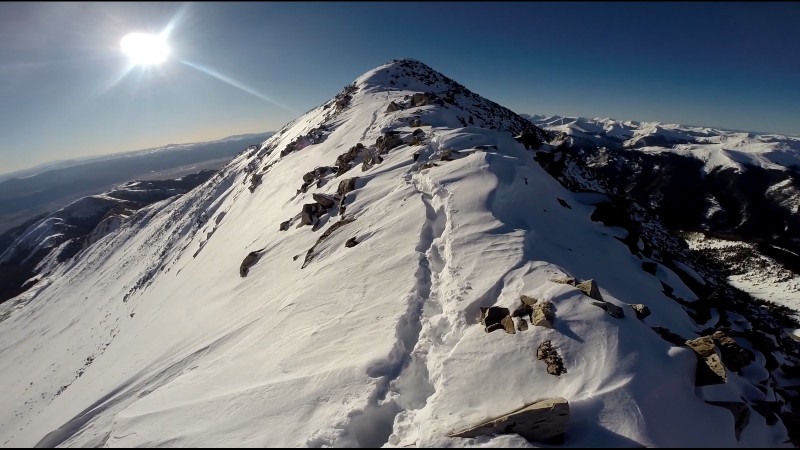 After going over the top, there was nothing higher anywhere around me. Though I missed the "official" cut-off, I'm counting this one as a "winter" ascent given the manner in which I climbed it for being "close enough." I don't typically run with purists in my social circle: their sense of self-righteousness and moral superiority grates on my nerves, so in my books, this was 14er summit number 2 in winter conditions. The views of Yale, while less impressive than from Huron, are certainly more expansive, given it's dominating position over Buena Vista and the Arkansas headwaters area. 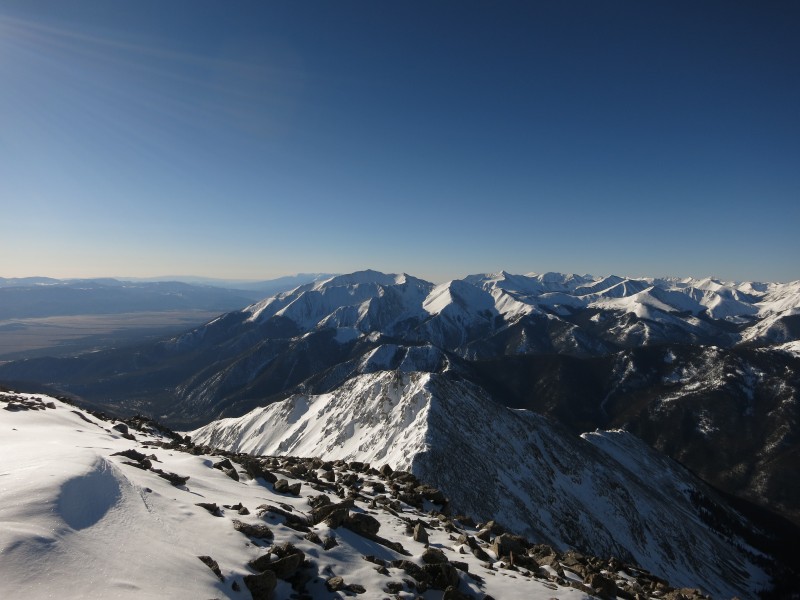 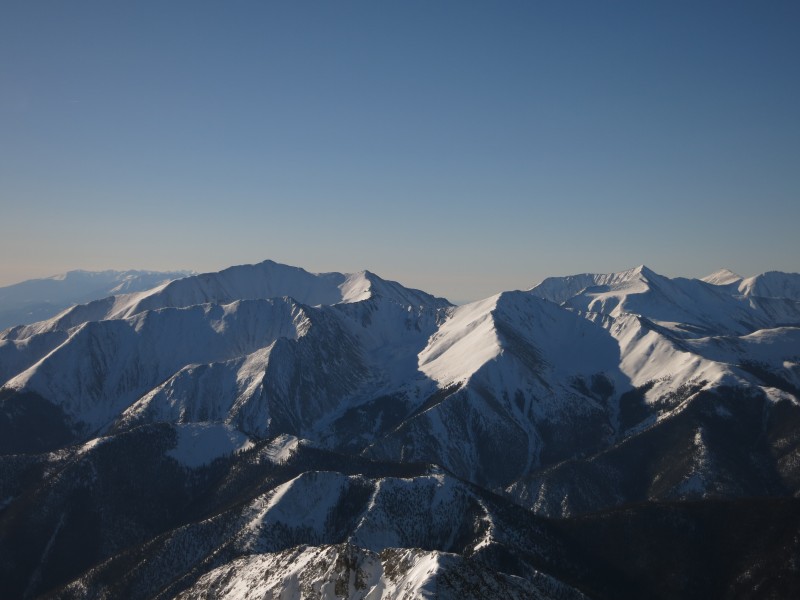 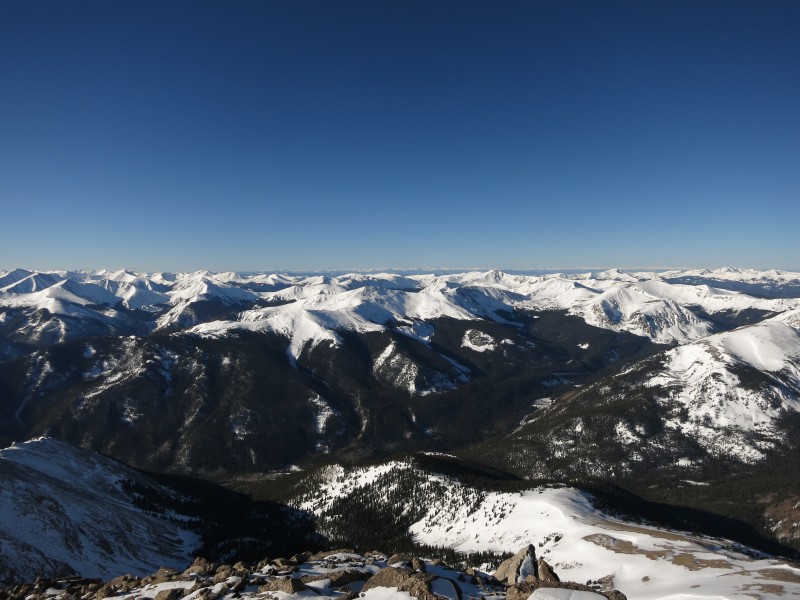 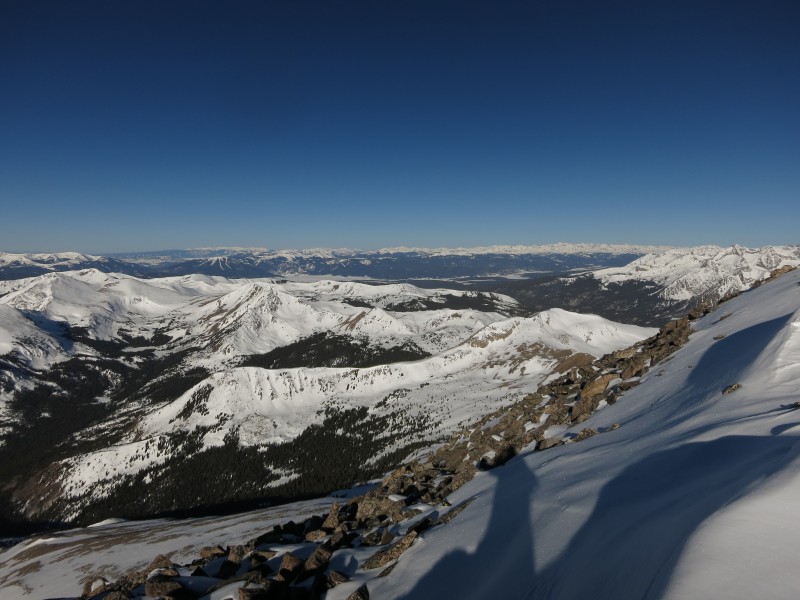 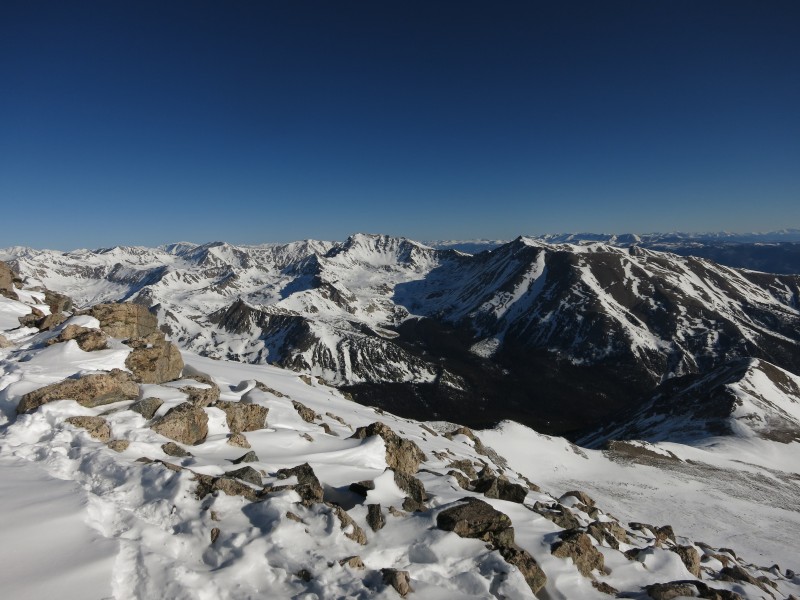 The descent, at this early hour, meant the hard snow made for poor glissading, but I still tried for it anyway. I moved in very short bursts since arresting at high speed would have been very difficult. This is the one drawback to the early start: to avoid postholing lower down in the forest, one is stuck with bulletproof snow on glissadeable aspects. While the people who climbed later in the day certainly enjoyed better (softer) snow for a glissade, I'm not sure the suffering they had to endure to exit the forest was necessarily worth it. 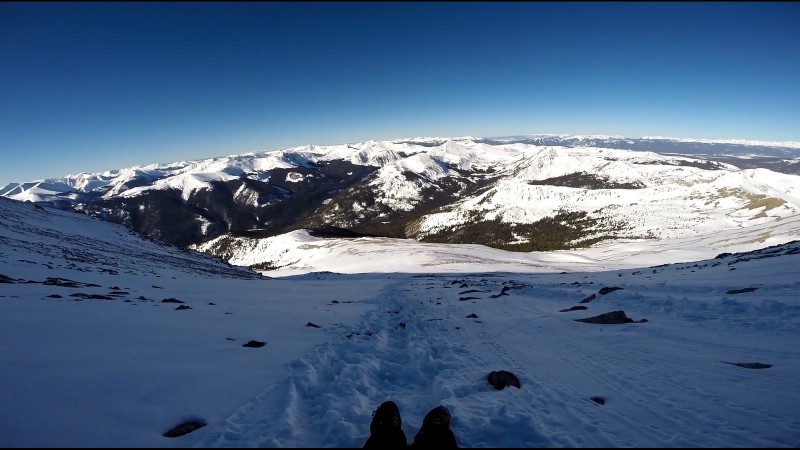 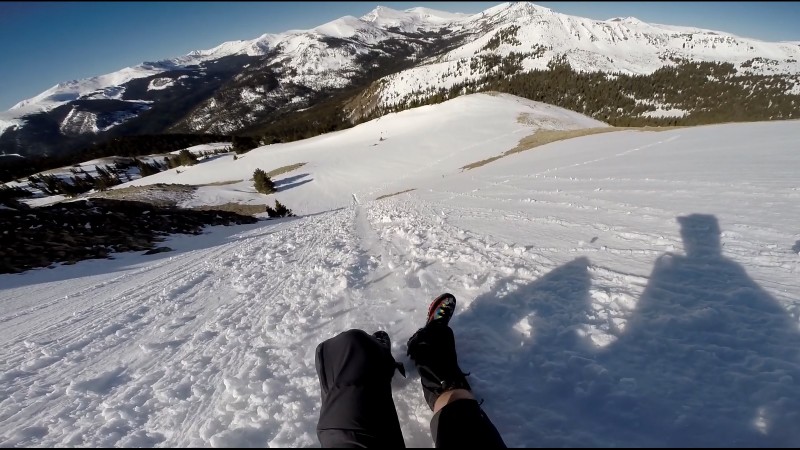 As I was wrapping up my first glissade down to the shoulder of Yale, I ran into two friendly guys who asked if I had stashed snowshoes near some boulders and left my poles at the base of a snow slope. I confirmed they were mine, and they told me they moved the poles into a tree near where I had left them, and something else about the snowshoes that I still can't remember. They seemed to think a lot of people were coming up the route from the busy parking lot and they wanted to protect me gear. I "thanked" them but privately wished they would have left the stuff alone. I did come across my poles in a tree at the base of my second glissade, but despite a 20 minute search, I could not find my showshoes. The four pounds of plastic and steel I carried from 9K' to 12K' without ever putting on that morning were gone. I was pretty frustrated about it, and because of the warming temperatures, I didn't waste more time looking for them. Now time was of the imperative, because postholing without snowshoes is the stuff of nightmares. I continued down the trench and came to the slope above treeline that had sketched me out in the pitch blackness of that morning. It really wasn't as steep as I had thought. By this point I had passed numerous parties heading up, and kept forgetting to ask them if they came up through treeline via a crappy snow chute in the trees.  Coming back into treeline, some hypocritical and "purist" part of me wanted to "fix" my error of the morning with getting off-route. I wanted to follow the "correct" way down the mountain, to avoid that slope of vile steep snow through the trees. I spotted this slope pretty easily, even having never seen it in daylight yet, and continued past it on the correct trail down. This part of the trench, however, disappeared only a few hundred feet beyond the sketch slope into fresh powder, and so I had two options: 1. build trench and route-find my way down this correct direction in fresh powder without snowshoes to the meadow of mysteries, OR 2. return up the trail to the awful slope I'd ascended from, and follow it down. In this case, my desire for "fixing" the earlier mistake was overridden by confidence in knowing how to get down. I knew it would be miserable, but at least I knew the way that direction. I stupidly and hurriedly decided to go for it without first re-attaching my microspikes (which I had removed for my glissades) and taking the axe back out, trying it out bare-boot and with my poles. Not three feet down the slope, the slick crust brought me back to Earth with a less than graceful slide down about thirty feet. I managed to avoid smacking any trees, and once I stopped and caught my breath, carefully stowed my poles, took out the axe, and put on the microspikes. I carefully downclimbed the remainder of the slope I hope to never see again, and with only minimal postholing, found my way back to the meadow of frustrations from earlier that morning. Here, I spent ten minutes scouting around for the "correct" trail I should have taken that morning before giving up and continuing the descent. My guess is that the primary trail was covered in new snow, and somebody's descent tracks were not, and so everybody going up turned the poor choice of trail into their route, making it seem heavily trafficked and hence the "main" route. Oh well. Despite all my fears and anxieties about hellish postholing back to the TH, the trench held up nicely given it was still early morning. I arrived back at the car around 1130, making for 5 and a half hours to summit and three hours from summit to car. The video linked at the top of this report does a significantly better job of showing off this route and the emotions associated with winter-ish climbing than the written word. |
| Comments or Questions | |||||||||||||||
|---|---|---|---|---|---|---|---|---|---|---|---|---|---|---|---|
|
Caution: The information contained in this report may not be accurate and should not be the only resource used in preparation for your climb. Failure to have the necessary experience, physical conditioning, supplies or equipment can result in injury or death. 14ers.com and the author(s) of this report provide no warranties, either express or implied, that the information provided is accurate or reliable. By using the information provided, you agree to indemnify and hold harmless 14ers.com and the report author(s) with respect to any claims and demands against them, including any attorney fees and expenses. Please read the 14ers.com Safety and Disclaimer pages for more information.
Please respect private property: 14ers.com supports the rights of private landowners to determine how and by whom their land will be used. In Colorado, it is your responsibility to determine if land is private and to obtain the appropriate permission before entering the property.
